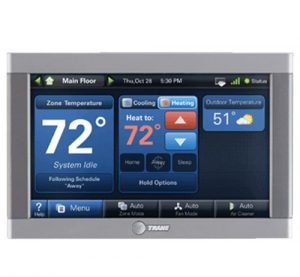Our houses are getting more intelligent and connected as technology advances.
One of the most innovative and useful devices to have emerged in recent years is the smart thermostat.
These devices have revolutionized the way we manage our indoor environment, offering a range of features and benefits that set them apart from traditional thermostats.
In this article, we’ll explore the key features, advantages, and potential drawbacks of smart thermostats to help you make an informed decision about whether they’re right for you.
What are Smart Thermostats?
A smart thermostat is a digital device that connects to your home’s heating and cooling system. It allows you to control the temperature and other settings remotely via an app on your smartphone or through a web interface.
They differ from traditional thermostats in their ability to learn your habits, adjust settings automatically, and provide data-driven insights to help you optimize your energy usage.
Let’s take a closer look at some of the key features that set smart thermostats apart from their traditional counterparts.
Key Features of Smart Thermostats
Each smart thermostat will have varying features, depending on its manufacturer. Below are some of the most common capabilities you may encounter:
Remote Temperature Control
One of the most notable features of a smart thermostat is its ability to be controlled remotely.
That means you can control the thermostat in your house from anywhere. Whether you’re at work, on vacation, or simply relaxing in bed.
This level of control can be incredibly convenient, as it allows you to ensure your home is always at the perfect temperature, even when your schedule is unpredictable.
Energy-Saving Settings
Smart thermostats are equipped with advanced algorithms that learn your habits and preferences over time.
This allows them to automatically adjust the temperature in your home based on factors like the time of day, the weather, and whether or not you’re at home.
You can expect significant energy savings and reduced utility bills, as the thermostat works to optimize your heating and cooling systems for maximum efficiency.
Compatibility with Voice Assistants and Smart Home Systems
Many smart thermostats support prominent voice assistants, for example:
- Amazon Alexa
- Google Assistant
- Apple Siri
This allows you to control your thermostat using voice commands, adding another layer of convenience to your smart home setup.
Additionally, smart thermostats can often be integrated with other smart home devices.
This includes things like smart lights and security systems, to create a fully connected and automated home environment.
Benefits of Smart Thermostats
Smart thermostats offer numerous benefits that cater to various aspects of home management, including cost savings, energy efficiency, and even air quality.
Let’s take a look at how smart thermostats can contribute to a more comfortable, environmentally friendly, and efficient home.
Receive Real-Time Alerts
Smart thermostats can send real-time alerts to your smartphone or email if there are any issues with your heating and cooling system or if the temperature in your home falls outside of your set parameters.
This enables you to take immediate action to address potential problems, such as:
- An overheating furnace
- A broken air conditioner
- A gas leak
- A refrigerant leak
This can help you prevent costly damages and maintain a comfortable living environment.
Improved Energy Efficiency
A smart thermostat can minimize energy waste and help you save on your utility bills. Many smart thermostats provide detailed energy reports that can help you identify patterns and make adjustments to further optimize your energy usage.
Boost Indoor Air Quality
Some smart thermostats are equipped with sensors that monitor indoor air quality, measuring factors such as:
- Humidity
- Carbon dioxide levels
- Airborne pollutants
By providing insights into your home’s air quality, these thermostats can help you make informed decisions about when to ventilate your home, use air purifiers, or adjust your HVAC system settings to maintain a healthy living environment.
Cost Savings on Utility Bills
While the upfront cost of a smart thermostat may be higher than that of a traditional thermostat, the potential savings on your energy bills can make the investment worthwhile in the long run.
According to some estimates, a smart thermostat can save you up to 20% on your heating and cooling costs.
Qualify for Energy Rebates
Many utility companies and government agencies offer rebates or incentives for homeowners who install energy-efficient devices like smart thermostats.
By participating in these programs, you may be able to recoup some of the initial costs of purchasing and installing a smart thermostat, making the investment even more financially appealing.
Extend HVAC Lifespan
By optimizing your home’s heating and cooling systems for maximum efficiency, smart thermostats can help reduce wear and tear on your HVAC equipment.
This can lead to fewer breakdowns, reduced maintenance costs, and an extended lifespan for your heating and cooling systems, saving you money in the long run.
Increase Home Resale Value
Installing a smart thermostat can be an attractive selling point when it comes time to put your home on the market.
Buyers are increasingly interested in energy-efficient and smart home technologies. Thus, having a smart thermostat already installed can help boost your home’s resale value and appeal to potential buyers.
Potential Drawbacks and Limitations of Smart Thermostats
While smart thermostats offer a range of benefits, there are a few potential drawbacks and limitations to consider before making the switch.
Upfront Cost
Smart thermostats can be more expensive than traditional thermostats, with prices ranging from $100 to $300 or more, depending on the model and features.
However, as mentioned earlier, the potential savings on your energy bills can help offset the initial investment over time.
Compatibility Issues
Some older heating and cooling systems may not be compatible with smart thermostats.
Some may even require additional wiring or components for the thermostat to function properly.
It’s essential to check compatibility with your specific system before purchasing a smart thermostat to avoid any surprises during installation.
Privacy Concerns
As with any internet-connected device, smart thermostats come with some privacy concerns.
The data collected by your thermostat, including your energy usage habits and preferences, could potentially be accessed by third parties or even hackers.
To minimize these risks, it’s crucial to choose a thermostat from a reputable manufacturer and follow best practices for securing your home network.
Installing a Smart Thermostat in Your Home
Installing a smart thermostat is generally quite simple and can be done by most homeowners, though some may prefer to hire a professional for the installation process.
Here’s a short guide to help you get an idea of the installation process:
Step 1: Turn off the power.
Before you begin, it’s essential to turn off the power to your HVAC system at the circuit breaker to ensure your safety during the installation process. This will help prevent any electrical accidents or damage to your equipment.
Step 2: Remove the old thermostat.
Carefully remove the faceplate of your existing thermostat, exposing the wiring underneath.
Take a picture or write down the wire connections. This will be helpful when you install your new smart thermostat.
Next, unscrew or disconnect the wires from the old thermostat, and then remove the thermostat base from the wall.
Step 3: Install the new thermostat base.
Follow the manufacturer’s instructions to mount the new smart thermostat base on the wall.
Ensure that it’s level and securely attached. If necessary, use the included wall anchors and screws to attach the base to the wall.
Step 4: Connect the wires.
Connect the cables from your HVAC system to the proper terminals on your new smart thermostat base, using the photo or notes you took previously.
Check that all connections are tight and that no exposed wires are present.
If your smart thermostat requires a C-wire (common wire) for power and your system doesn’t have one, you may need to install a C-wire adapter (which is often included with the thermostat) or consult a professional for assistance.
Step 5: Attach the faceplate and turn on the power.
Once the wires are connected, carefully attach the smart thermostat faceplate to the base, making sure it snaps or clicks into place.
Turn the power back on at the circuit breaker, and then follow the manufacturer’s instructions to set up and configure your new smart thermostat.
This may involve connecting it to your Wi-Fi network, downloading an app, and customizing your settings.
A Smart and Efficient Home
Smart thermostats offer a host of benefits that make them an appealing option for homeowners looking to improve their energy efficiency, save on utility bills, and enjoy greater convenience and comfort.
While there are some potential drawbacks and limitations to consider, the advantages of smart thermostats often outweigh the downsides for many homeowners.
If you’re considering making the switch to a smart thermostat, be sure to research different models and features to find the perfect fit for your home and lifestyle.
You may also enlist the assistance of a professional heating and cooling service, like BelRed Energy Solutions!
Quality Services You Can Trust
At BelRed Energy Solutions, we specialize in providing reliable and efficient AC Repair, Installation & Services to keep your home cool and comfortable all season long.
Our experienced technicians are committed to delivering exceptional service, from routine maintenance to complete system replacements.
We understand that every home is unique, which is why we take the time to assess your specific cooling needs and offer customized solutions to ensure optimal performance and energy efficiency.
When you choose BelRed Energy Solutions, you’re choosing a team that values quality, professionalism, and customer satisfaction.
We stand by our work and are dedicated to ensuring your AC system runs smoothly and efficiently, saving you money on energy bills and providing you with the ultimate comfort in your home.







